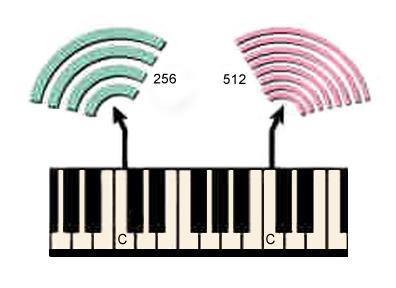Sound - Mechanical Vibrations - Pressure Waves

The sensory organs of the eye, ear, tongue and skin are each sensitive to specific forms of energy. The nose and tongue detect chemical energy, the eye detects light energy, the skin detects heat and mechanical energy. Sound is a form of mechanical energy. Mechanical forces can be steady, like the weight of this journal in your hand, or they can vibrate, like your car when it goes over speed bumps. Sound is generated by mechanical vibrations (such as a vibrating piano string). This sets up small oscillations of air molecules that in turn cause adjacent molecules to oscillate as the sound propagates away from its source. Sound is called a pressure wave because when the molecules of air come closer together the pressure increases (compression) as they mover further apart the pressure decreases (rarefaction). Since a pressure wave consists of a molecular disturbance, sound waves cannot travel through a vacuum. The velocity of sound in air is around 1,100 ft/sec which is why dividing the seconds between seeing lightning and hearing thunder by 5 gives a rough measure in miles of how far the lightning is from you. Sound waves travel fastest in solids, slower in liquids and slowest in air. Sound vibrations extend from a few cycles per second to millions of cycles per second. Human hearing is limited to a range of between 20 to 20,000 cycles per second. Sound at a vibration rate of greater than 20,000 cycles per second is called ultrasound. Other mammals can hear ultrasound, some such as whales approach 100,000 cycles per second. Physicians now use imaging techniques based on ultrasound (mechanical vibrations at millions of cycles per second) to examine the unborn child.
A sound is characterized by its frequency and intensity. The frequency of a sound contributes to its pitch and is measured by counting the number of cycles per second in the vibration. Intensity is a measure of loudness. If you have ever played a piano, you know where middle C is on the keyboard (see Figure 1). If the piano is properly tuned, middle C has a frequency of 256 cycles per second, high C (7 white keys to the right) has a frequency of 512 cycles per second. People with normal hearing can tell the difference between two sounds that differ by less than 0.5 percent. In order to appreciate how small a difference in frequency this is you need only realize that middle C differs from C sharp (the black piano key immediately to its right of C) by more than 5 percent.
The intensity of a sound is a measure of its loudness and reflects how tightly packed the molecules of air become during the compression phase of a sound wave. The ear can detect sounds where the vibration of the air at the ear drum is less than the diameter of a hydrogen molecule. The ear has the ability to discriminate intensities over a 100,000 fold difference in energy. Still louder sounds can cause pain and damage the structures of the inner ear.
The task of all hearing organs is to analyze environmental sounds and transmit the results of that analysis to the brain. The brain interprets the ear’s analysis. All sensory organs have specialized sensory cells that convert an environmental signal into electrical energy. The change in electrical energy is then converted to a type a digital code that is transmitted to the brain. The human auditory system performs an analysis of sound entering the ear prior to the conversion to the neural code. The inner ear first determines how much energy is contained at the different frequencies that make up a specific sound. The cochlea is designed so that it is most sensitive to a specific frequency (say middle C) at one location and most sensitive to another frequency (say high C) at another. These different locations then transmit information to the brain. If the brain receives an increase in activity from the middle C location it then knows that the original sound contained energy at that frequency. This "mapping" of frequency information is just one of several strategies that the ear uses to code incoming information. The frequency analysis of environmental sounds begins in the external ear.
Next chapter: Getting Sound to the Inner Ear - The Analysis of Sound Begins
Return to the table of contents of How the Ear Works








